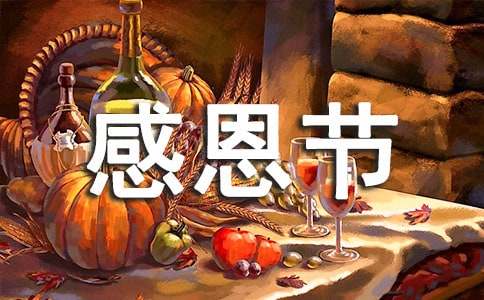- 感恩節英語手抄報內容 推薦度:
- 相關推薦
關于感恩節英語手抄報內容
在各個領域,大家都聽說過或者使用過手抄報吧,手抄報能有效幫助我們獲得信息,培養綜合能力。你所見過的手抄報是什么樣的呢?下面是小編精心整理的關于感恩節英語手抄報內容,歡迎大家分享。

感恩節的由來Origin of Thanksgiving Day
Thanksgiving originated origin can be traced back to the history of the United States, originated in the early settlers of Plymouth, Massachusetts. Known as the pilgrims when these immigrants in the UK, because of their religious reform of the church of England is not completely, and the king and the church of England repression of their political and religious persecution, so the pilgrims from the church of England, go to the Netherlands, then decided to move to the other side of the Atlantic that desolate land, hope to be able to freely according to their wishes religious life.
In 1620, the famous "mayflower" ship loaded with unbearable the Britain domestic religious persecution Puritan 102 people had arrived in America. In 1620 and 1621, the turn of the winter, they met with refugees brought the necessities, also specially taught them how to hunting, fishing and planting corn, pumpkin. With the help of the indians, immigrants finally won a harvest, in the days of harvest celebration according to religious traditions, immigration rules the day of Thanksgiving to god, and decided to thank the indians sincere help, inviting them to celebrate the festival together.
In late Thursday in November 1621, the pilgrims and massa soder 90 indians gathered, celebrated the first Thanksgiving Day in American history. A backwater at dawn, they marched into a room full of served as a church, devoutly grateful to god, and then lit a bonfire held a grand banquet, will hunt turkeys hospitality indians made delicacies. The second day and on the third day again held activities such as wrestling, running, singing and dancing. Male pilgrims go out hunting, capture the Turkey, women in the home made from corn, pumpkin, sweet potatoes and fruit such as delicacies. In this way, whites and indians around the bonfire, chating at, also singing and dancing, the whole celebration lasted three days. Many of the first Thanksgiving celebration has been circulated.
感恩節的由來可以追溯到美國歷史的發端,起源于馬薩諸塞普利茅斯的早期移民。這些移民在英國本土時被稱為清教徒,因為他們對英國教會的宗教改革不徹底感到不滿,以及英王及英國教會對他們的政治鎮壓和宗教迫害,所以這些清教徒脫離英國教會,遠走荷蘭,后來決定遷居到大西洋彼岸那片荒無人煙的土地上,希望能按照自己的意愿信教自由地生活。
1620年,著名的“五月花”號船滿載不堪忍受英國國內宗教迫害的清教徒102人到達美洲。1620年和1621年之交的冬天,他們遇到了難民送來了生活必需品,還特地派人教他們怎樣狩獵、捕魚和種植玉米、南瓜。在印第安人的幫助下,移民們終于獲得了豐收,在歡慶豐收的日子,按照宗教傳統習俗,移民規定了感謝上帝的日子,并決定為感謝印第安人的真誠幫助,邀請他們一同慶祝節日。
1621年11月下旬的星期四,清教徒們和馬薩索德帶來的90名印第安人歡聚一堂,慶祝美國歷史上第一個感恩節。他們在黎明時鳴放禮炮,列隊走進一間用作教堂的屋子,虔誠地向上帝表達謝意,然后點起篝火舉行盛大宴會,將獵獲的火雞制成美味佳肴盛情款待印第安人。第二天和第三天又舉行了摔跤、賽跑、唱歌、跳舞等活動 。男性清教徒外出打獵、捕捉火雞,女人們則在家里用玉米、南瓜、紅薯和果子等做成美味佳肴。就這樣,白人和印第安人圍著篝火,邊吃邊聊,還載歌載舞,整個慶祝活動持續了三天 。第一個感恩節的許多慶祝方式一直流傳后代 。
感恩節來歷
Thanksgiving Day is a holiday in the United States and Canada, first created in the United States to express gratitude to Native Americans. Later, people often thank others on this day. Since 1941, Thanksgiving Day has been celebrated on the fourth Thursday of November each year, during which one takes a two-day holiday to reunite with ones family. Thanksgiving Day falls between November 22-28 each year and is the most authentic and American holiday among national holidays in the United States. Canadas Thanksgiving Day began in 1879 and falls on the second Monday of October each year.
At the beginning of Thanksgiving, there was no fixed date and it was decided by each state on a temporary basis. Until 1863 after the independence of the United States, President Lincoln declared Thanksgiving a national holiday.
The last Thursday in November is Thanksgiving Day. Thanksgiving is an ancient holiday created by the American people, and it is also a holiday for families to gather together. Therefore, Americans always feel very familiar when mentioning Thanksgiving.
The origin of Thanksgiving can be traced back to the beginning of American history. In 1620, the famous Mayflower ship arrived in America loaded with 102 Puritans who could not bear religious persecution within England. During the winter at the turn of 1620 and 1621, they encountered unimaginable difficulties and were in a state of hunger and cold. As the winter passed, only about 50 immigrants survived. At this time, the kind-hearted Native Americans brought essential necessities to the immigrants and even sent people to teach them how to hunt, fish, and grow corn and pumpkins. With the help of the Native Americans, the immigrants finally achieved a bountiful harvest. On the day of celebrating the harvest, in accordance with religious traditions and customs, the immigrants set a day to thank God and decided to invite them to celebrate the holiday together in gratitude for the sincere help of the Native Americans.
On the first day of Thanksgiving, Native Americans and immigrants gathered together, firing salutes at dawn, marching into a room used as a church, devoutly expressing gratitude to God, and then lighting a bonfire for a grand banquet. On the second and third days, activities such as wrestling, running, singing, and dancing were held. The first Thanksgiving was very successful. Many of these celebration methods have been passed down for over 300 years and have been preserved to this day.
感恩節(ThanksgivingDay),美國和加拿大節日,由美國首創的,原意是為了感謝印第安人,后來人們常在這一天感謝他人。自1941年起,感恩節是在每年11月的第四個星期四,在這一天起將休假兩天,都要和自己的家人團聚,感恩節在每年11月22—28日之間,感恩節是美國國定假日中最地道、最美國式的節日,加拿大的感恩節則起始于1879年,是在每年10月第二個星期一。
初時感恩節沒有固定日期,由各州臨時決定。直到美國獨立后的1863年,林肯總統宣布感恩節為全國性節日。
11月的最后一個星期四是感恩節(ThanksgivingDay)。感恩節是美國人民獨創的一個古老節日,也是美國人合家歡聚的節日,因此美國人提起感恩節總是倍感親切。
感恩節的由來要一直追溯到美國歷史的發端。1620年,著名的“五月花”號船滿載不堪忍受英國國內宗教迫害的清教徒102人到達美洲。1620年和1621年之交的冬天,他們遇到了難以想象的困難,處在饑寒交迫之中,冬天過去時,活下來的移民只有50來人。這時,心地善良的印第安人給移民送來了生活必需品,還特地派人教他們怎樣狩獵、捕魚和種植玉米、南瓜。在印第安人的幫助下,移民們終于獲得了豐收,在歡慶豐收的日子,按照宗教傳統習俗,移民規定了感謝上帝的日子,并決定為感謝印第安人的真誠幫助,邀請他們一同慶祝節日。
在第一個感恩節的這一天,印第安人和移民歡聚一堂,他們在黎明時鳴放禮炮,列隊走進一間用作教堂的屋子,虔誠地向上帝表達謝意,然后點起篝火舉行盛大宴會。第二天和第三天又舉行了摔跤、賽跑、唱歌、跳舞等活動。第一個感恩節非常成功。其中許多慶祝方式流傳了300多年,一直保留到今天。
感恩節英文詩歌
《Thanksgiving》
Be thankful that you dont already have everything you desire,
If you did, what would there be to look forward to?
Be thankful when you dont know something,
For it gives you the opportunity to learn.
Be thankful for the difficult times,
During those times you grow.
Be thankful for your limitations,
Because they give you opportunities for improvement.
Be thankful for each new challenge,
Because it will build your strength and character.
Be thankful for your mistakes,
They will teach you valuable lessons.
Be thankful when youre tired and weary,
Because it means youve made a difference.
Be thankful for your past relationships,
Someone better suited to you is waiting out there.
Its easy to be thankful for the good things.
A life of rich fulfillment comes to those who
are also thankful for the setbacks.
Gratitude can turn a negative into a positive.
Find a way to be thankful for your troubles,
and they can become your blessings.
【感恩節英語手抄報內容】相關文章:
2015感恩節英語手抄報內容01-30
2015感恩節英語手抄報內容(精選)01-29
2015年感恩節英語手抄報內容01-29
2015關于感恩節英語手抄報內容01-29
感恩節英語手抄報內容 Thanksgiving day01-30
感恩節手抄報內容:感恩節的習俗01-29
2015感恩節手抄報內容:感恩節的來歷01-29
2015感恩節手抄報內容:感恩節的意義01-29
圣誕節的英語手抄報內容12-27